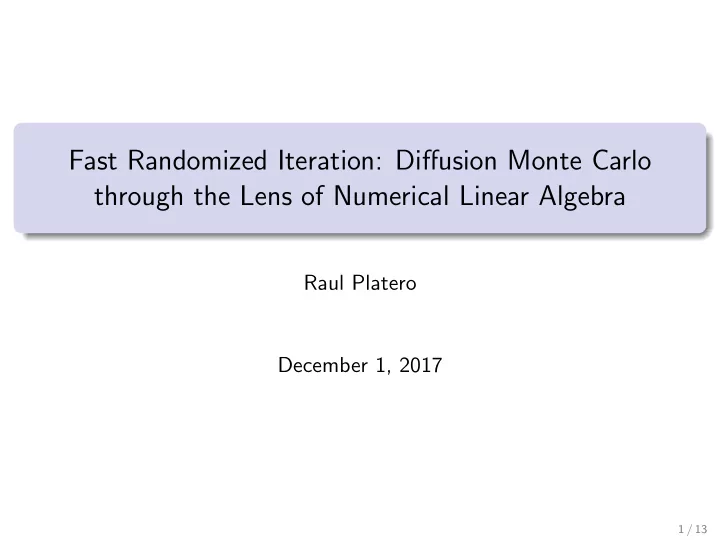

Fast Randomized Iteration: Diffusion Monte Carlo through the Lens of Numerical Linear Algebra Raul Platero December 1, 2017 1 / 13
August 2017, Lek-Heng Lim, Jonathan Weare Modification to diffusion Monte Carlo techniques to solve common linear algebra problems (i.e. matrix exponentiation, solving linear systems, and eigenvalue problems) Fast Randomized Iteration can deal with dimensions far beyond the present limits of numerical linear algebra Motivated by recent application of diffusion Monte Carlo schemes to matrices as large as 10 108 × 10 108 2 / 13
Diffusion Monte Carlo Quantum Monte Carlo: computational methods for studying quantum systems using Monte Carlo Diffusion is quantum but when studying zero-temperature systems most commonly used for computing ground state’s energy of electrons (i.e. solve for the smallest eigenpair of a matrix) 3 / 13
Diffusion Monte Carlo Imaginary-time Schr¨ odinger equation: ∂ t v = −H v Solved by the following iterative method: e − ǫ H v t − 1 λ t = − 1 � e − ǫ H v t − 1 ( x ) dx ǫ log and v t = � e − ǫ H v t − 1 ( x ) dx Include random approximations V m of v t . t N t W ( j ) � V m t ( x ) = δ X ( j ) ( x ) , t t j =1 where δ y ( x ) is a Dirac delta function centered at y ∈ R d , the W ( j ) are t j =1 W ( j ) real, non-negative numbers with E [ � N t ] = 1, and, for each j ≤ N t , t X ( j ) ∈ R d . t 4 / 13
Diffusion Monte Carlo First randomization: � ǫ 2 ∆ δ y ]( x ) dx = E y [ f ( B ǫ )] , f ( x )[ e a special case of the Feynman-Kac formula, where f is a test function, B s is a standard Brownian motion evaluated at time s ≥ 0. Let ˜ V m = K ǫ V m t − 1 , t where K ǫ is the discretization of e − ǫ H . Then we can write ˜ m V m W ( j ) t +1 δ ( j ) t +1 � V m t +1 = � ˜ = , ξ ( j ) V m t +1 ( x ) dx t +1 j =1 where weights are recursively defined 2 ( U ( ǫ ( j ) t +1 )+ U ( X ( j ) ǫ )) W ( j ) e t W ( j ) t t +1 = . 2 ( U ( ǫ ( ℓ ) t +1 )+ U ( X ( ℓ ) ǫ )) W ( ℓ ) � m ℓ =1 e t t Cost for a single iteration is O ( dm ). 5 / 13
Diffusion Monte Carlo Second randomization: Points ξ ( j ) do not reference the potential U (sampled from m independent j Brownian motions). Control growth in variance by removing points with very small weights and duplicate points with large weights. V m becomes Y m with t t E [ Y m t | V m t ] = V m t . This has a cost of O ( m ) thus overall cost per iteration is still O ( dm ). 6 / 13
Diffusion Monte Carlo 1 Generate Y m = Φ m t ( V m t ) with approximately or exactly m nonzero t entries. K ǫ Y m 2 Set V m t +1 = t || 1 . t || K ǫ Y m Unable to store iterates v t using typical sparse matrix routines No direct dependence on size of K ǫ 7 / 13
Fast Randomized Iteration FRI: V m t +1 = M (Φ m t ( V m t )) , t : C n → C n satisfying E [Φ m where Φ m t ( v )] = v . 8 / 13
Compression Rules A simple choice: � || v || 1 v j N j if | v j | > 0 m | v | j (Φ m t ( v )) j = 0 if | v j | = 0 where each N j is a random, nonnegative, integer. This scheme is suboptimal as it does not increase sparsity as error increases which drives efficiency of FRI. 9 / 13
Compression Rules 10 / 13
Numerical Results Main competitor involves truncation-by-size (TbS) schemes. TbS - thresholding where v σ j is set to zero for j > m where j is largest element of v . Results based on matrix arising in the spectral gap of a diffusion process governing the evolution of a system of up to five two-dimensional particles. Matrix of up to size 10 20 × 10 20 11 / 13
Numerical Results 12 / 13
Numerical Results 13 / 13
Recommend
More recommend